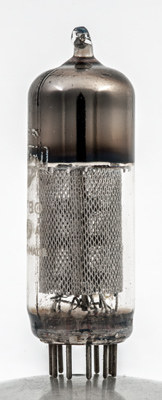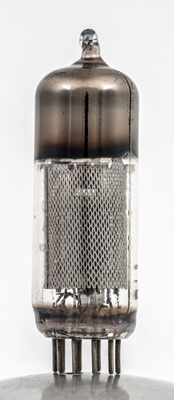The EF80 internally screened pentode was a workhorse of the VHF TV receiver and was introduced in mid 1950 to replace the EF91. It was described by Mullard as: a high slope RF pentode and not a variable μ type. The EF85 was the variable μ counterpart to the EF80.The EF80 was much used for RF, intermediate frequency, and video amplification.The 'bog standard' TV of the later 1950s was full of EF80s (or equivalents). In those days all British TVs were monochrome, 405-line standard, with a typical video IF of 33 MHz. The EF80 worked well at 40 MHz and also gave adequate performance at up to 100 MHz. The EF80 was superseded in the 1960s by the higher slope frame grid EF184 the EF183 being the variable μ design.The EF80 was a reliable design.The circuit designer is given maximum flexibility by having all electrodes brought to external pins. Many pentodes have g3, the suppressor grid, internally connected to the cathode.Unlike our other Mullard EF80 the mesh screen is much longer and shields above and below the mica discs.
The screen hides the inner detail but the dark band at the centre indicates a two plate anode joined with a strap. Thus the electrons are only accelerated in a direction normal to the grid axis.
The top third of the envelope is occupied only by the gettering.The thin glass tube envelope is 20 mm diameter and excluding the B9A base pins, is 59 mm tall.References: Data-sheet & 1040. Type EF80 was first introduced in 1950. See also 1950 adverts. |